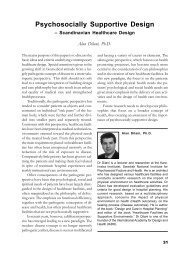Medical Research and its Impact on Healthcare Design - the ...
Medical Research and its Impact on Healthcare Design - the ...
Medical Research and its Impact on Healthcare Design - the ...
Create successful ePaper yourself
Turn your PDF publications into a flip-book with our unique Google optimized e-Paper software.
MEDICAL RESEARCH AND ITS IMPACT ON HEALTHCARE DESIGNof acti<strong>on</strong> of different drugs will make it possibleto improve <strong>the</strong> <strong>the</strong>rapeutic precisi<strong>on</strong> <str<strong>on</strong>g>and</str<strong>on</strong>g>efficiency.• Selective drugs (serot<strong>on</strong>in inhibitors) withminimal side effects have been introduced<str<strong>on</strong>g>and</str<strong>on</strong>g> will be improved.• New drugs are being designed which will affect<strong>the</strong> serot<strong>on</strong>in system according to a differentmechanism of acti<strong>on</strong>. These drugs willalso be effective against so called “<strong>the</strong>rapyresistant”c<strong>on</strong>diti<strong>on</strong>s.• The mode of acti<strong>on</strong> of lithium will be solvedwhich will create a basis for <strong>the</strong> developmentof new substances with less toxicity.• Development of more selective drugs withfewer side effects for <strong>the</strong> treatment of schizophrenia.• New methods for <strong>the</strong> optimisati<strong>on</strong> of <strong>the</strong>dose of neuroleptica based <strong>on</strong> PET studiesof dopamine-receptor localisati<strong>on</strong>.• A breakthrough in <strong>the</strong> underst<str<strong>on</strong>g>and</str<strong>on</strong>g>ing of <strong>the</strong>pathogenesis of schizophrenia can be expected.Therapy in <strong>the</strong> future – some speculati<strong>on</strong>s• Producti<strong>on</strong> of new types of drugs <str<strong>on</strong>g>and</str<strong>on</strong>g> vaccinesusing biotechnology. E.g. TPA producedby biotechnological methods will be usedin treatment of thrombosis in <strong>the</strong> brain <str<strong>on</strong>g>and</str<strong>on</strong>g>heart (acute myocardial infarcti<strong>on</strong>) <str<strong>on</strong>g>and</str<strong>on</strong>g> erythropoietinat anaemia caused by renal disorders.The genes coding for most of <strong>the</strong>lymphocytes have been sequenced which willmake recombinant substances available for<strong>the</strong>rapeutic use.• Gene <strong>the</strong>rapy will be possible for m<strong>on</strong>ogeneticdiseases like Duchenne’s muscular dystrophy,using adenovirus vectors.• The etiological mechanisms behind <strong>the</strong> originof immunologicalinflammatory diseases likediabetes type 1, multiple sclerosis, rheumatoidarthritis will be solved <str<strong>on</strong>g>and</str<strong>on</strong>g> make preventi<strong>on</strong>possible.• HIV <str<strong>on</strong>g>and</str<strong>on</strong>g> AIDS treatment will be improvedby <strong>the</strong> introducti<strong>on</strong> of new drugs. It is howeverdoubtful whe<strong>the</strong>r it will be possible tocreate a vaccine against HIV.• Vaccines against malaria, cholera <str<strong>on</strong>g>and</str<strong>on</strong>g> ordinarycold will be developed.<strong>Healthcare</strong> developmentThe development in <strong>the</strong> healthcare organisati<strong>on</strong>is directed towards a process-oriented systemwhich h<strong>on</strong>our keywords such as “patient orientati<strong>on</strong>”,“knowledge navigati<strong>on</strong>”, “coordinati<strong>on</strong>/feedback”<str<strong>on</strong>g>and</str<strong>on</strong>g> “benchmarking” <str<strong>on</strong>g>and</str<strong>on</strong>g> whichforms a logistic chain from “Social security system”– “Pre venti<strong>on</strong> care” – “Primary medicalcare” – “Diag nostics” – “Therapeutics” – Rehabilita ti<strong>on</strong>” – “Work/retirement” to “Follow-upmeasures” <str<strong>on</strong>g>and</str<strong>on</strong>g> includes patient-centred hospitals.The evoluti<strong>on</strong> can be illustrated as followsTodayFragmented servicesTreating illnessesAcute, inpatient careInstituti<strong>on</strong>al measuresPerceived qualityIndividual IT systemsTomorrowC<strong>on</strong>tinuum of careManaging healthPreventive/primarycareCommunity measuresOutcome measures,report cardsIntegrated IT networksThis shift will most likely lead to a partial disintegrati<strong>on</strong>of <strong>the</strong> omnipotent “Mega-instituti<strong>on</strong>s”,which try to cover everything in <strong>the</strong> medicalarea, <str<strong>on</strong>g>and</str<strong>on</strong>g> <strong>the</strong> formati<strong>on</strong> of smaller customized<str<strong>on</strong>g>and</str<strong>on</strong>g> specialized un<str<strong>on</strong>g>its</str<strong>on</strong>g> which will collaborate inan integrated network, much based <strong>on</strong> moderninformati<strong>on</strong>-communicati<strong>on</strong> technologies. Thehealth care system will gradually move from an“informati<strong>on</strong> hierarchy” to an “informati<strong>on</strong>hyperarchy”. We will see <strong>the</strong> development ofa health network which integrates <strong>the</strong> informati<strong>on</strong>flow related to <strong>the</strong> individual patient in <strong>the</strong>following way.In this way it will be possible to integrate <strong>the</strong>45
















